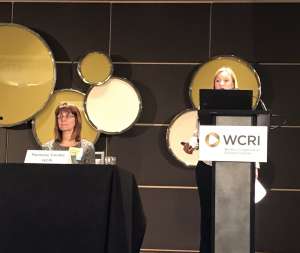Nationwide Workers’ Comp Trends from WCRI
At the 2019 WCRI Annual Conference, a session discussed some of the latest findings and trends seen across WCRI’s core benchmark studies, including WCRI’s 18-state CompScope™ Benchmarks reports. The presenters were: Moderator: Ms. Ramona P. Tanabe, WCRI Speakers: Ms. Carol A. Telles, WCRI, Facility Costs and Use: Factors in Interstate Differences and Trends Ms. Evelina Radeva, WCRI, Comparing Benefit Delivery Expenses Dr. Rebecca Yang, WCRI, Frequency and Costs of Lump-Sum Settlements Facility Metrics Facility payments accounted for 9-25% of total medical costs across 18 states studied. The median was 17%. Facility payments are seen on 26-44% of total claims. There was wide variation
(Read the full article…)
Group Health Deductibles and Workers’ Compensation
At the 2019 WCRI Annual Conference, Dr. Olesya Fomenko, WCRI, discussed their study on how higher deductibles for group health plans may impact workers’ compensation claims activity. According to a Kaiser Family Foundation study, the average group health plan deductible in 2008 was $765. In 2014 that number was $1217 and by 2017 that number was up to $1505, During that same time, the percentage of workers enrolled in group health plans with deductibles above $1000 increased from under 20% to over 50%. The major findings of the WCRI study were: Patients do respond to cost sharing arrangements on their
(Read the full article…)
Washington State and Washington DC’s efforts on Return to Work
At the 2019 WCRI Annual Conference a session discussed efforts in Washington State and Washington DC to promote return to work following a work injury. The speakers were: Moderator: Dr. John W. Ruser, WCRI Speakers: Ms. Jennifer Sheehy, U.S. Department of Labor’s Office of Disability Employment Policy (ODEP) Prof. Tom Wickizer, University of Washington School of Public Health Washington State Much of the work related disability could be significantly reduced with more efficient and effective occupational medicine treatment. Washington has a monopolistic workers’ compensation system which enables them to have a greater degree of control over claims and medical providers
(Read the full article…)
Opioids in Workers’ Compensation: Research and Reduction Efforts
At the 2019 WCRI Annual Conference, a session discussed a variety of research and efforts relating to the opioid epidemic. Moderator: Mr. Tim Hassett-Salley, WCRI Speakers: Dr. Vennela Thumula, WCRI Dr. Letitia Davis, Massachusetts Department of Public Health Ms. Jacqueline Kurth, Industrial Commission of Arizona Mr. Jason Porter, Industrial Commission of Arizona WCRI Research Older workers tended to receive slightly more opioid prescriptions than younger ones. Specifically, 42% of workers age 23-38 received an opioid prescription vs 49% of workers over age 55. From an industry standpoint, mining and construction workers had a higher percentage of opioid prescriptions compared to
(Read the full article…)
Policies Impacting the Workforce Now and the Future
At the 2019 WCRI Annual Conference, Dr. John W. Ruser, WCRI and Prof. Alan Kruegar, Princeton University, kicked off the conference with a keynote focused on the opioid epidemic, participation in the US labor force, and the state of the US economy. Opioid Epidemic The opioid overdose rate in the US has been steadily climbing since 1999 and it has increased over 250% during this time period. In 2017 over 70,000 Americans died from a drug overdose. This crisis is impacting mortality rates in the US as life expectancies have been declining here since 2000 directly linked to drug overdoses. The
(Read the full article…)
Disaster Planning and Response
At the 2019 PARMA Annual Conference, Kimberly George from Sedgwick and Mark Walls from Safety National hosted a live “Out Front Ideas with Kimberly and Mark” event focused on disaster planning and response for public entities. The panelists were: Martin Brady – Schools Insurance Authority Tim Karcz – California Joint Powers Insurance Authority Bill Simonson – State of California Office of Risk Managment PRE-EVENT PLANNING Disaster planning starts at the local level. It should include a large cross section of your public entity officials including police, firefighters, emergency services, elected officials, schools, utilities, street/highway departments, risk management, etc. The bigger
(Read the full article…)
Biggest Risk Management Challenges Facing Public Entities
At the 2019 PARMA Annual Conference, Kimberly George from Sedgwick and Mark Walls from Safety National hosted a live “Out Front Ideas with Kimberly and Mark” event that featured a panel of risk managers discussing their biggest challenges. The panelists were: Michael Alio – County of Orange Sergio Cazorla – Baldwin Park USD Steven Robles – County of Los Angeles Jonathan Shull – California Joint Powers Insurance Authority The panel discussed a wide variety of topics including: CYBER Your employees are your front line of defense. This requires constant training for them to identifying suspicious emails that may be an
(Read the full article…)
Auto Accident Reconstructon
At the 2019 PARMA Annual Conference, Jeffrey Bonsall from Momentum Engineering discussed how accident reconstruction can be useful in investigating auto accidents. Steps in Accident Investigation Determine causal factors Collect and retain data Access damages Provide key information to make informed decisions Effectively communicate with experts Access the necessity of working with other experts Useful Data Sources For Accident Investigation Police reports Online video including news video Social media Repair estimates Quality photos (original JPEG file) Deposition testimony and recorded Statements Transportation engineering records A rapid response accident investigation will include: Preserving evidence through early scene documentation and physical evidence
(Read the full article…)
Autonomous Vehicle Levels & Technologies
In this presentation at the PARMA 2019 Annual Risk Management Conference, Anthony Andreoni, PE, MBA, ASE, at Jensen Hughes, provided information about the latest autonomous vehicle technologies and driver-assist systems. According to SAE International, the global leader in technical learning for the mobility industry, there are currently five levels of autonomy for vehicles: Level 0 – No Automation: Zero autonomy. The driver performs all driving tasks. Level 1 – Driver Assistance: Vehicle is controlled by the driver, but includes some driving assistance features. Level 2 – Partial Automation: Has combined automated functions like acceleration and steering, but the driver must
(Read the full article…)
Settlement and Closure of Safety Officer Claims
All too often, public agency loss runs contain a high number of unresolved claims or future medical claims where sworn officers will not consider settlement. It is a phenomenon that every agency grapples with and no one seems to have the solution. This session at the PARMA 2019 Annual Risk Management Conference investigated why this occurs and explored ideas to help settle these claims. Speakers included: Keith Epstein, Hanna Brophy Law Firm Alexander Wong, Jones Clifford Law Firm Frank Grgurina, Ret. Public Safety Director City of Sunnyvale Remembering the Mission: To Protect & Serve Many agencies with sworn officers are
(Read the full article…)











